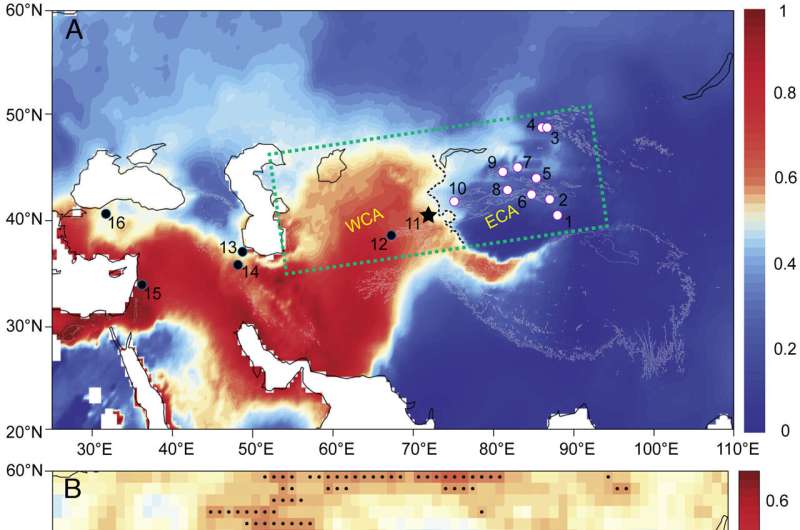This article has been reviewed according to Science X's editorial process and policies. Editors have highlighted the following attributes while ensuring the content's credibility:
fact-checked
peer-reviewed publication
trusted source
proofread
Scientists reveal hydroclimatic changes on multiple timescales in Central Asia over the past 7,800 years

A recent study published in the PNAS shows that western Central Asia has experienced a long-term drying trend over the past 7,800 years. This discovery, based on the analysis of a stalagmite from the Fergana Valley in Kyrgyzstan, adds a critical piece to the understanding of westerly-influenced hydroclimatic patterns in Central Asia.
Central Asia is among one of the most important arid regions in the world. With the acceleration of global warming, the region faces severe challenges such as accelerated glacier melting, shrinking lakes, and water scarcity. The shrinking of the Aral Sea has been described as "one of the planet's worst environmental disasters."
Because of these challenges, understanding the long-term hydroclimatic changes that have occurred throughout Central Asia during the Holocene is essential for predicting future precipitation trends and their potential impacts on social development.
To address these challenges, a collaborative research group led by Prof. Tan Liangcheng from the Institute of Earth Environment of the Chinese Academy of Sciences used multiple proxies (δ18O, δ13C, and Sr/Ca) derived from the stalagmite to reconstruct a precisely dated and highly resolved hydroclimatic record in western Central Asia.
"Our results indicate a long-term drying trend in western Central Asia, which contrasts sharply with the wetter conditions observed in eastern Central Asia," said Dr. Tan.
This disparity is attributed to the different responses of winter and summer westerly jets to seasonal changes in solar radiation. Since the Holocene, reduced summer insolation in the Northern Hemisphere has led to a strengthening and southward shift of the summer westerly jet, resulting in a wetter trend in summer precipitation-dominated eastern Central Asia.
Conversely, in the winter precipitation-dominated western Central Asia, influenced by increased winter insolation in the Northern Hemisphere, the winter westerly jet stream shifted northward, accompanied by temperature rises, reducing Mediterranean storm activity and thus decreasing water vapor transport to Central Asia, leading to reduced winter precipitation and snowfall.
"This implies that the vast region may face a further reduction in precipitation with the continued increase in winter solar radiation and global warming," said Dr. Tan.
Furthermore, the researchers found significant quasi-periods of 1,400 years, 50–70 years, and 20–30 years that may be related to North Atlantic climate variability, indicating broader climatic connectivity. In particular, the identified centennial- to decadal-scale droughts and pluvial periods could have profound impacts on the regional societies and trans-Eurasian cultural exchange. For example, a severe drought about 5,180–5,820 years ago hindered the expansion of Central Asian culture and delayed the cultural development along the prehistoric Silk Road oasis route.
After the great drought disaster, the gradual recovery of precipitation promoted the prosperity of the Bronze Age civilization in Central Asia, marked by the rise of the Bactria-Margiana Archaeological Complex. In addition, the expansion of the Persian Empire (550 B.C. to 330 B.C.) corresponded well with the pluvial period in the vast region in 2,360 to 2,500 years ago.
Experts in the field assert that the comprehensive climate sequences uncovered in this study provide unprecedented temporal resolution and shed light on the complex climate dynamics of Central Asia. This discovery not only deepens our understanding of the regional hydroclimate history, but also improves the projections of how future climate change will affect this ecologically sensitive area.
More information: Liangcheng Tan et al, Hydroclimatic changes on multiple timescales since 7800 y BP in the winter precipitation–dominated Central Asia, Proceedings of the National Academy of Sciences (2024). DOI: 10.1073/pnas.2321645121
Journal information: Proceedings of the National Academy of Sciences
Provided by Chinese Academy of Sciences



















